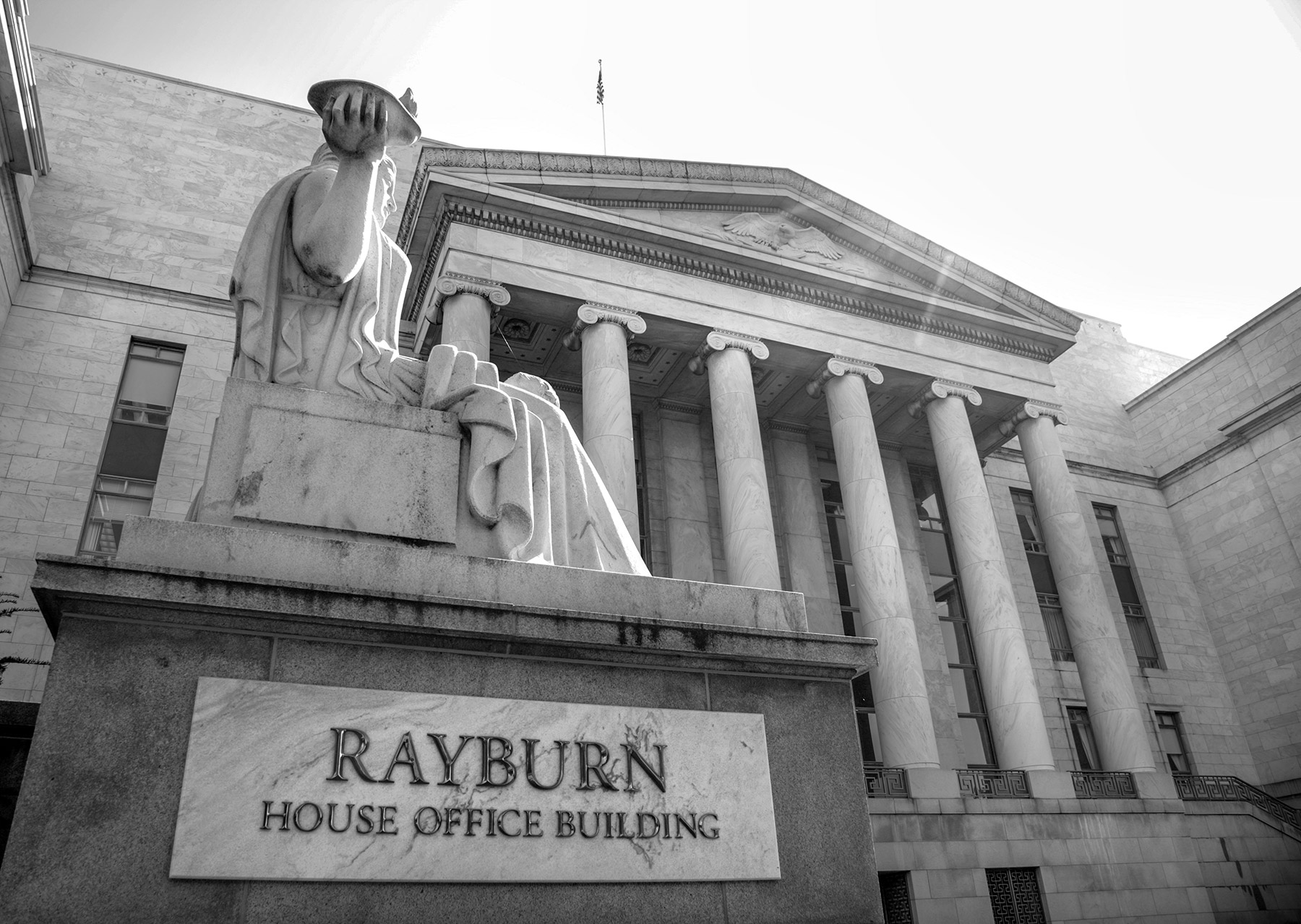U.S. Election Analysis 2018: Insights for Counties From the Midterm Elections
Upcoming Events
Related News
Introduction: Midterm elections set up divided 116th Congress
https://www.youtube.com/embed/00yBWVrWtpc
NACo Executive Director Matthew Chase provides an overview of NACo's 2018 election analysis.
Four years of bicameral Republican control of Congress will end in January after Democrats secured a majority in the U.S. House of Representatives in the 2018 midterm elections. Whether or not this result is considered a “blue wave,” Democratic momentum heading into the elections failed to prevent Republicans from maintaining and strengthening their majority in the U.S. Senate, setting up a divided 116th Congress that could be marked by partisan contention and gridlock. In races for governorships and state legislatures throughout the country, meanwhile, Democrats made considerable gains, chipping away at significant majorities built by Republicans over the last several years.
U.S. Congress
Heading into the midterm elections, two factors seemed likely to influence the outcome in Congress: the historical improbability of the president’s party maintaining control in the House, and a particularly challenging set of races for Democrats in the Senate. With most races settled, each of these factors has played out as predicted. Republicans lost at least 30 seats in the House, continuing a trend that has seen an average loss of 25 seats for the president’s party in midterm elections since World War II. Democrats, meanwhile, were felled in the Senate by an election map that called for the party to defend 27 of 33 contested seats, including blue seats in five states that President Trump won by at least 18 points in 2016.
The end result is a divided 116th Congress in which both parties could struggle to advance their legislative priorities. In the House, the impact of the Democrats’ victory will be tempered by the party’s relatively slim majority in the chamber and, more importantly, continued Republican control of the White House and Senate. In the upper chamber, a likely 2-seat gain will increase the GOP’s margin for internal dissent in confirmations of federal judges and cabinet officials, but the party is still several votes short of a filibuster-proof majority.
On some issues – including several key county issues – alignment of the parties’ priorities could result in bipartisan agreement on major pieces of legislation. The day after the election, Senate Majority Leader Mitch McConnell (R-Ky.) expressed willingness to work with Democratic House leadership on a new infrastructure package, which President Trump has cited as a priority throughout his administration. Several other legislative packages could become bipartisan priorities in the next Congress if they are not first addressed in the final “lame duck” weeks of the current session, including an overdue reauthorization of the farm bill and potential movement on a major criminal justice reform bill.
Governorships
Outside the nation’s capital, 36 states held gubernatorial races in the 2018 midterm elections. Democratic candidates fared well in these races, managing to flip seven governorships previously held by Republicans: Illinois, Kansas, Maine, Michigan, Nevada, New Mexico and Wisconsin. Despite this sizeable shift, the GOP will retain control of a majority of governors’ mansions across the country, thanks to its 33-governorship majority heading into the midterm elections and pickup of a formerly-Independent seat in Alaska, leaving the party in control of 27 states heading into 2019.
State Legislatures
Democratic momentum in the midterm elections carried over to state legislatures, where Democrats flipped a total of six legislative chambers in five states: Colorado’s Senate, Maine’s Senate, Minnesota’s House, New Hampshire’s House and Senate and New York’s Senate. The House in Alaska, on the other hand, switched from Democratic to Republican hands. Overall, Democrats reduced the Republican control of state legislative chambers from 67 heading into the midterm elections to a still-significant 62 heading into 2019.
|
Election Overview & Historical Trends |
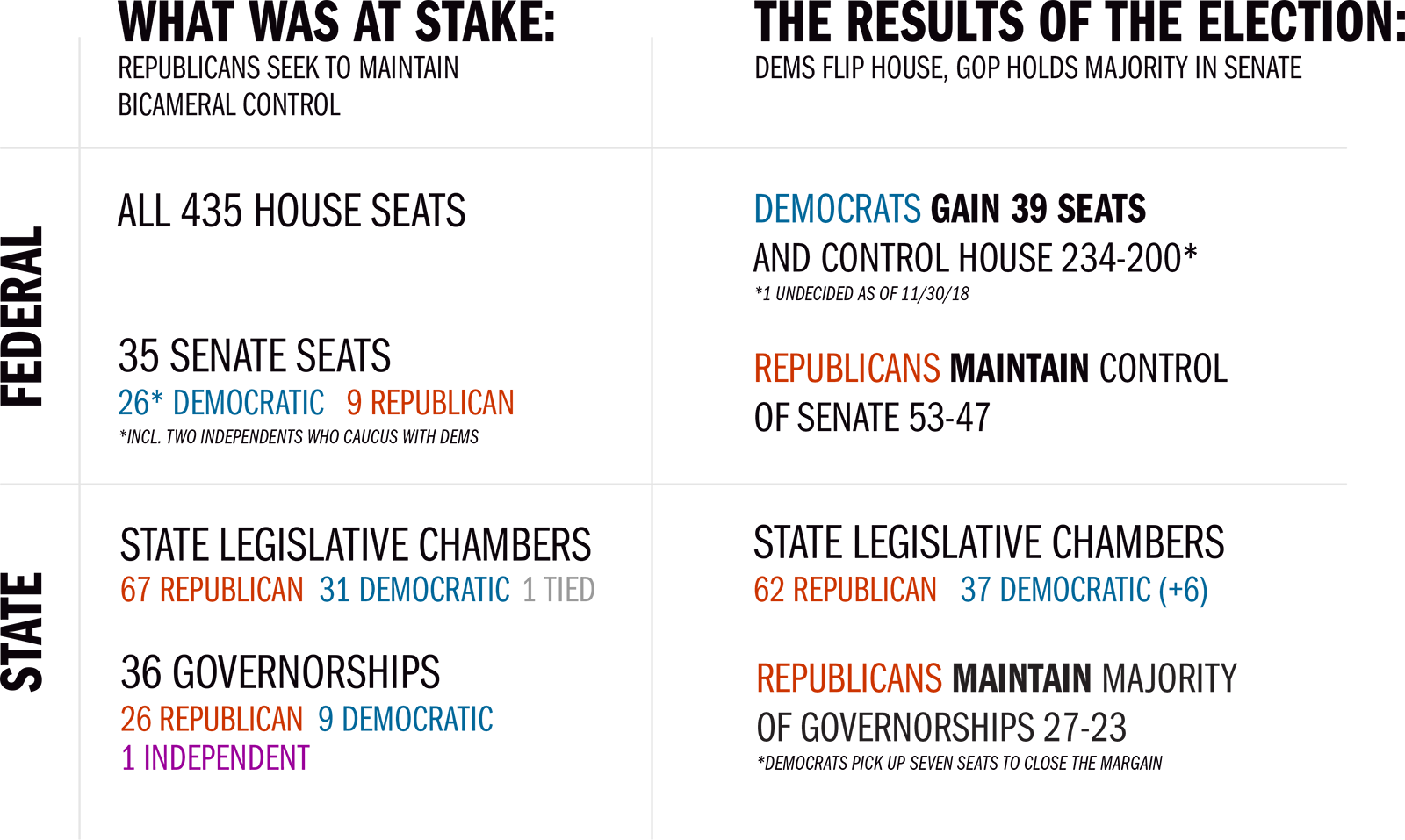
Midterm Election Turnout Throughout History
Y-axis represents percentage of registered voters who voted
Midterm Turnout Rose Sharply In 2018, with the highest percentage of registered voters who voted since 1966
Control of the House After Midterms Throughout History
Historic trends hold as president's party suffers midterm losses in the U.S. House
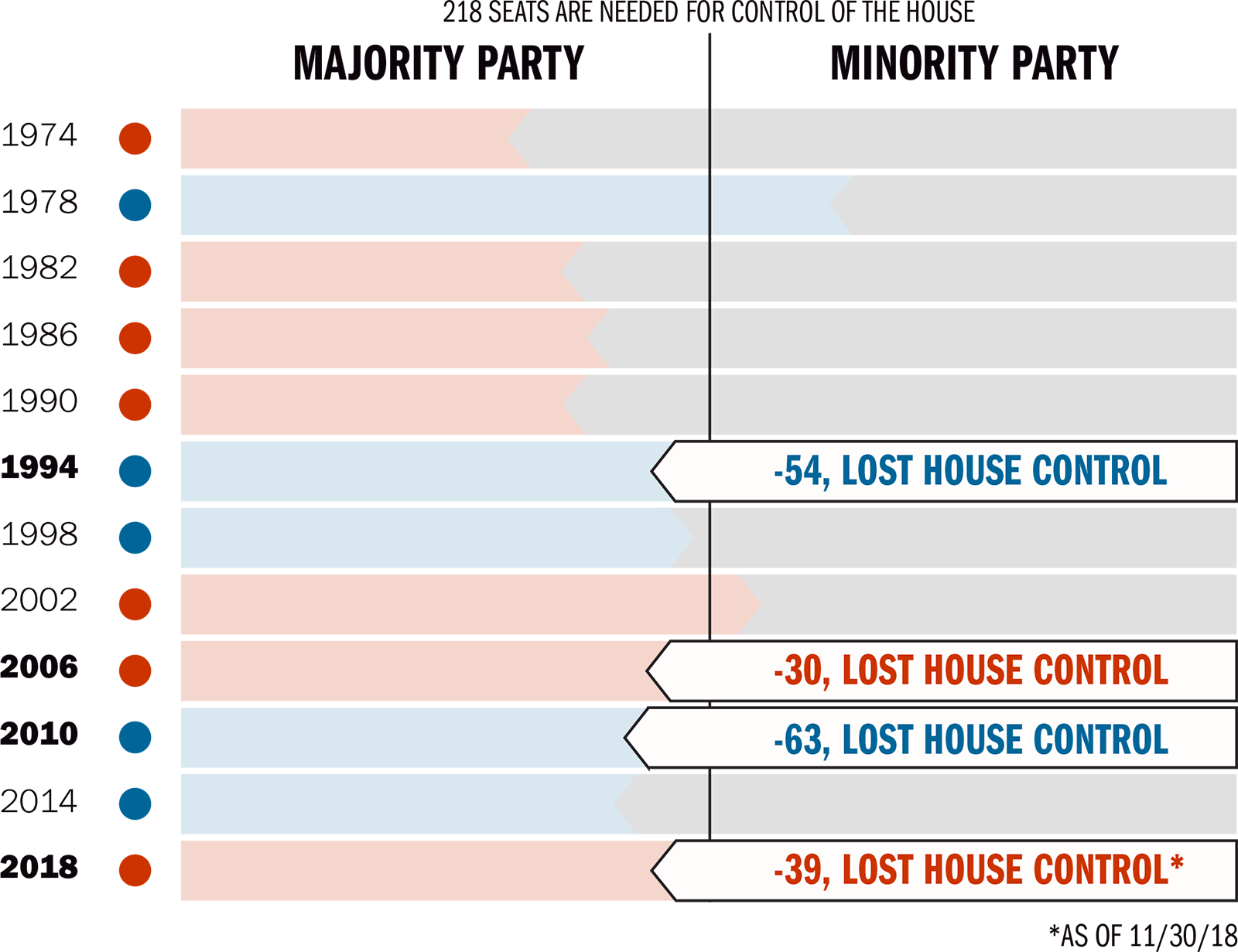
1998 and 2002 are the only two years (in the last 30) in which a president gained seats during the midterm election.
2018 marks the fourth time (year bolded) in the last 12 midterm elections in which losses by the president’s party resulted in loss of the U.S. House.
Record Number of Women in Congress
Continuing a decades-long trend, the 116th Congress will feature the largest number of women serving in the House and Senate, with at least 123 members set to serve in the new Congress across both chambers.
|
Senate Races |
Republicans Retain Control Over the Senate
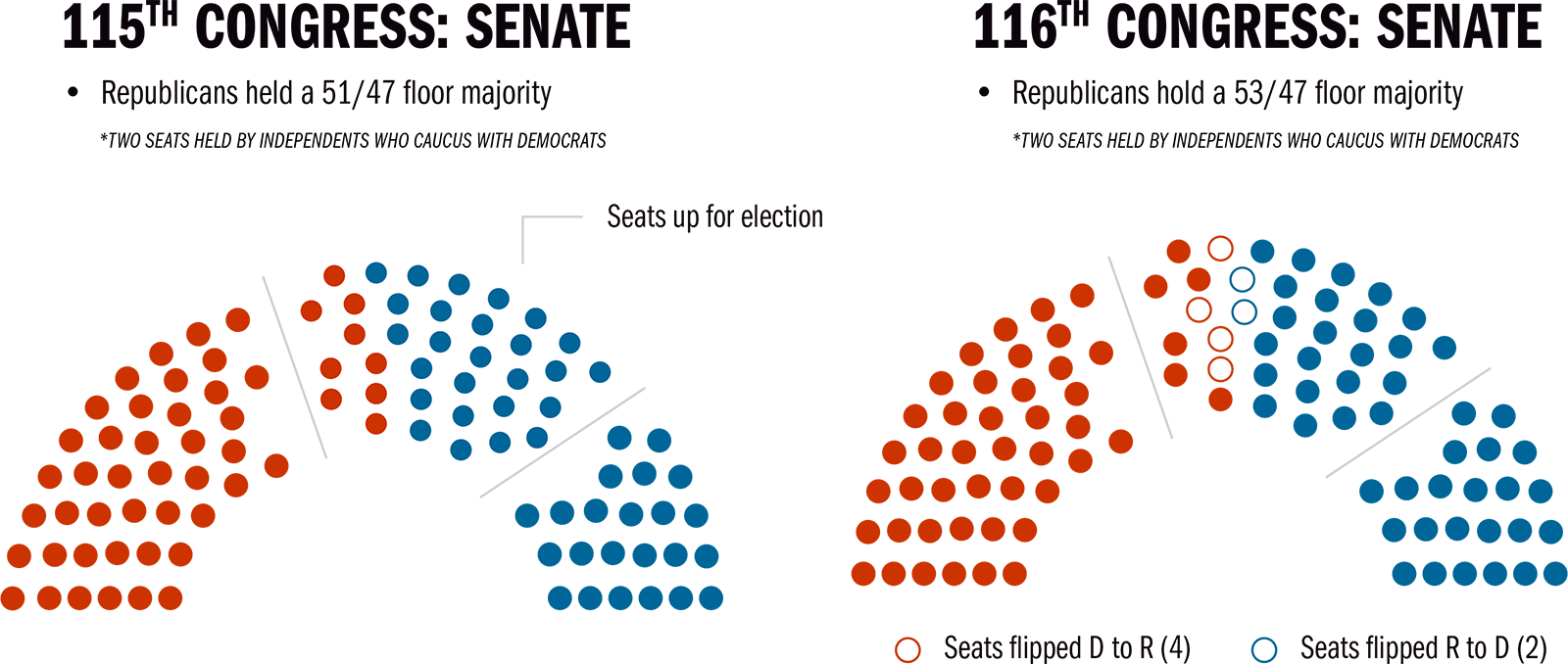
Republicans Retain Control of the Senate 53-47*
In Minnesota and Mississippi, both Senate seats were up for election in 2018 due to the resignations of former Sens. Al Franken and Thad Cochran.
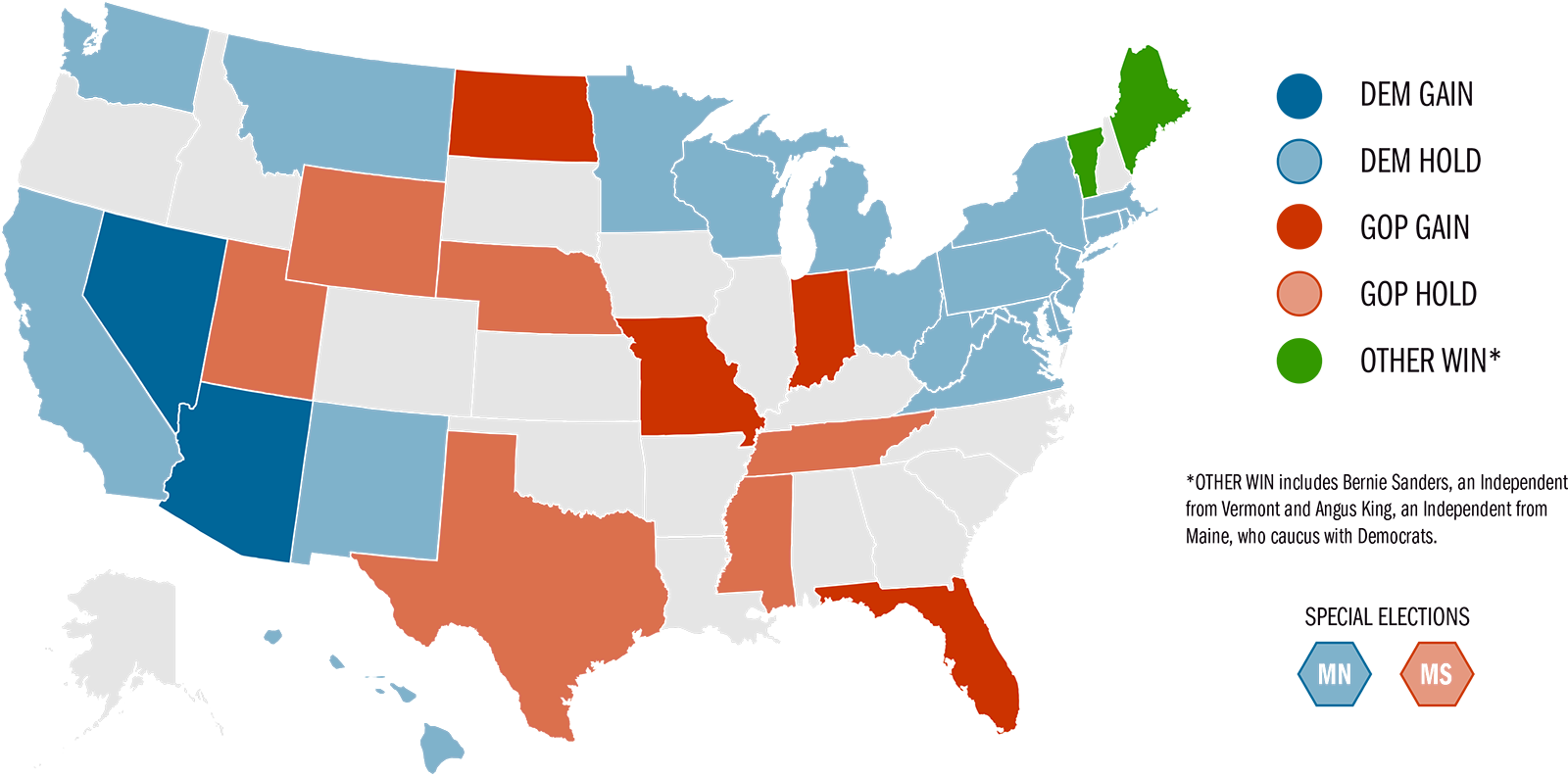
2018 Senate vs. 2016 Presidential Election Results
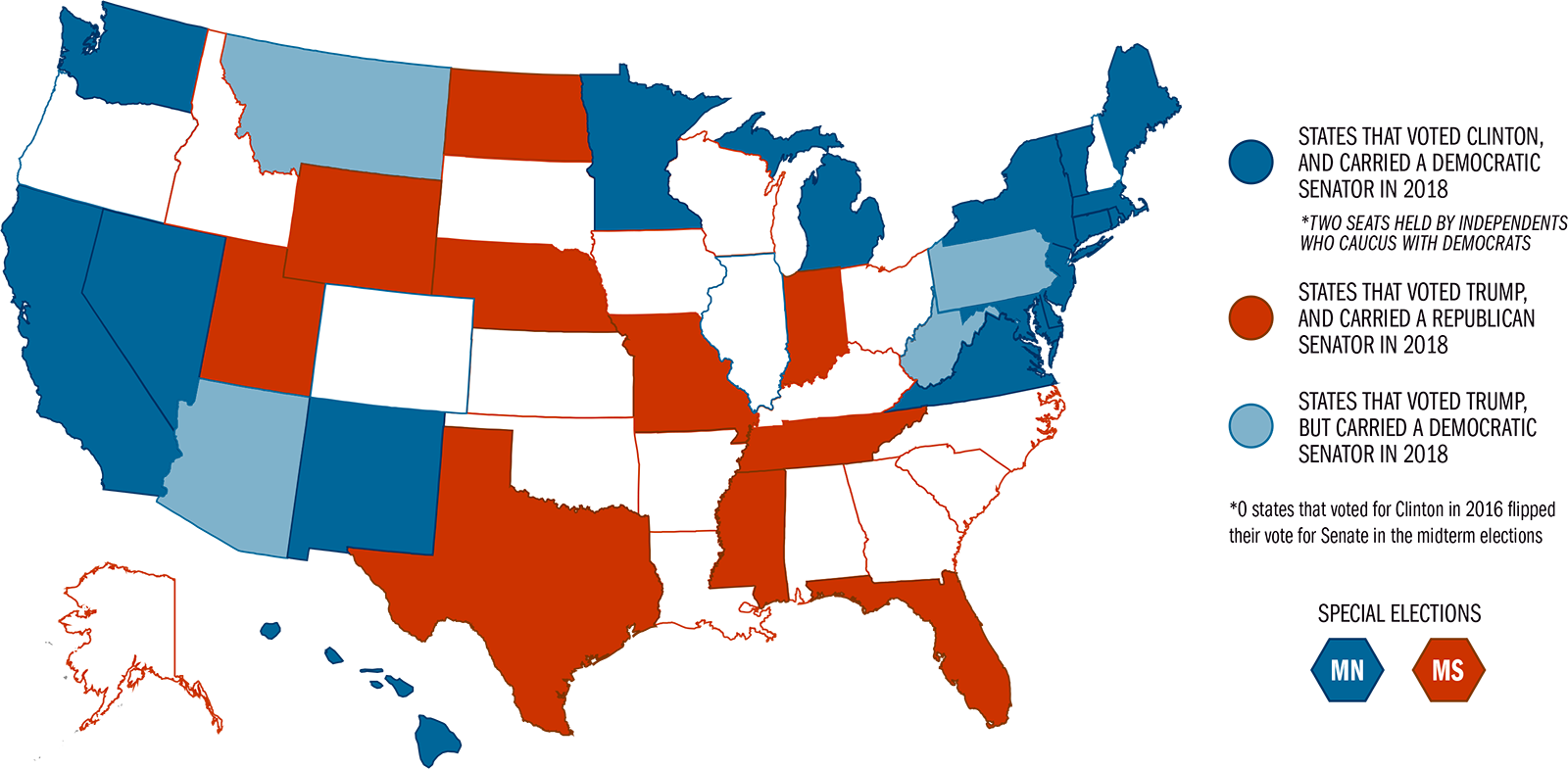
2018 Senate Election Results
| Key | ||
| Democrat Gain | Democrat Hold | Independent Hold |
| Republican Gain | Republican Hold | Too Close to Call |
New Faces in the Senate
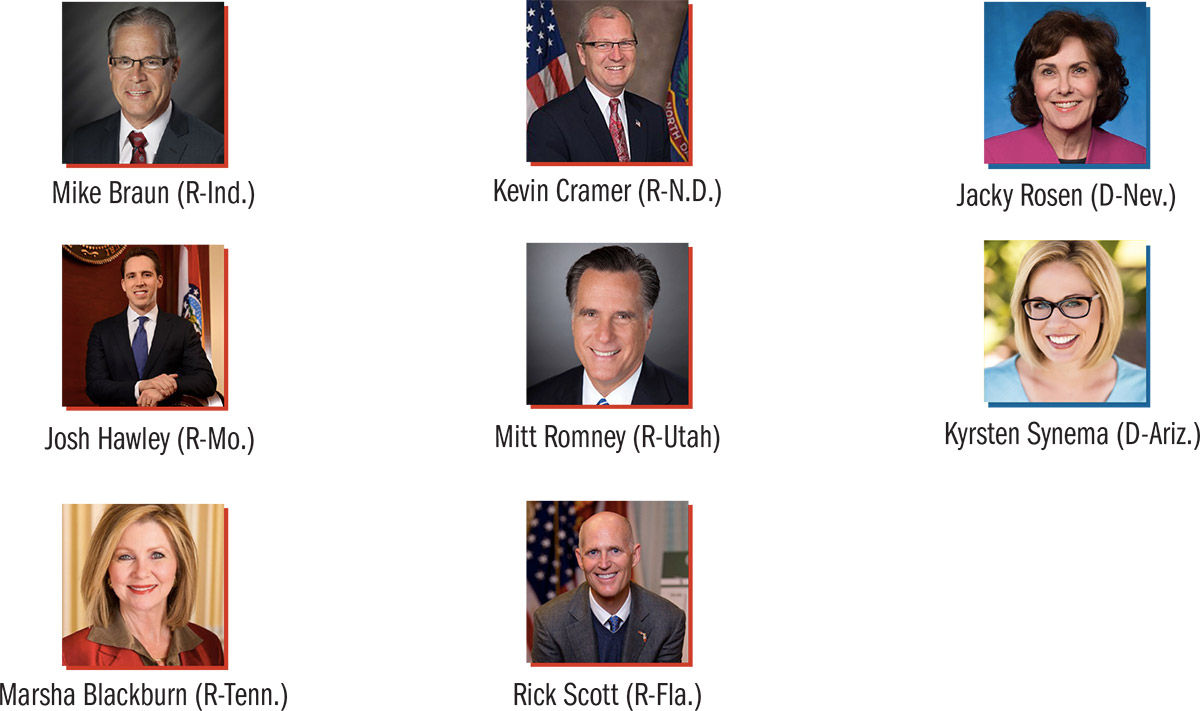
Faces Leaving the Senate
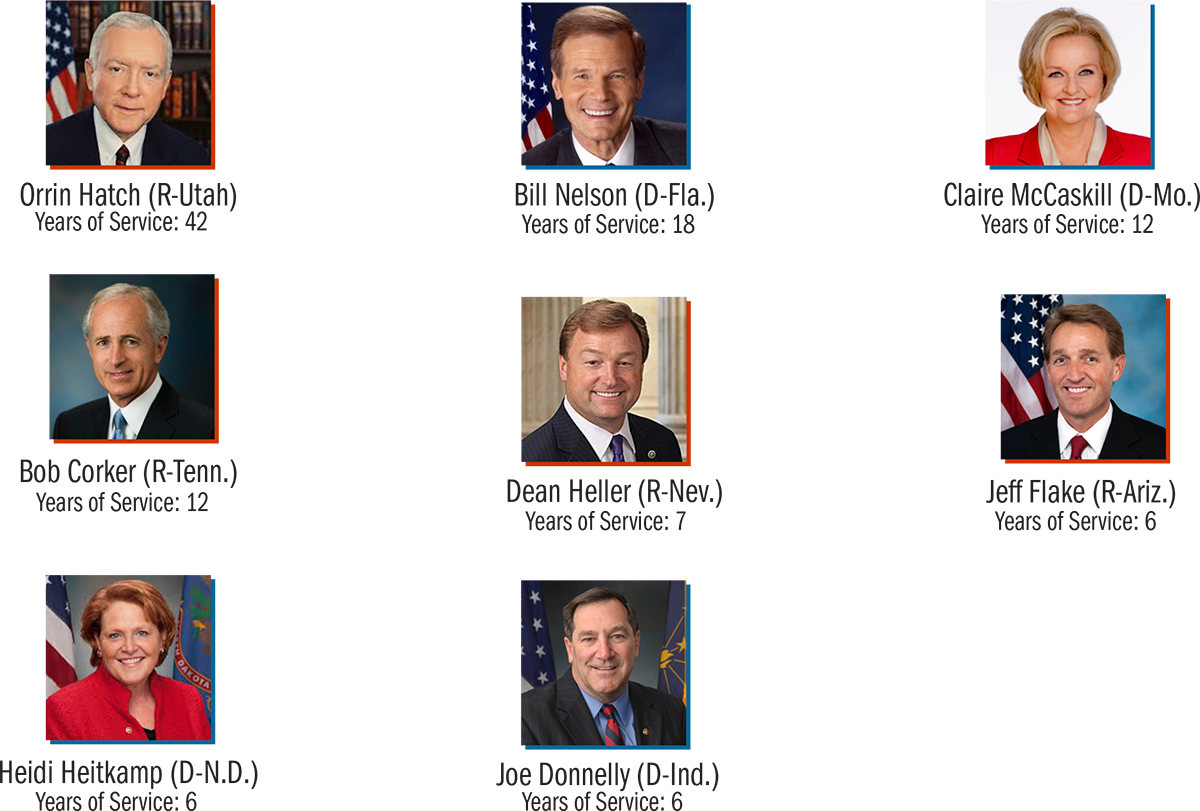
|
U.S. House of Representatives |
Democrats Gain Control of House
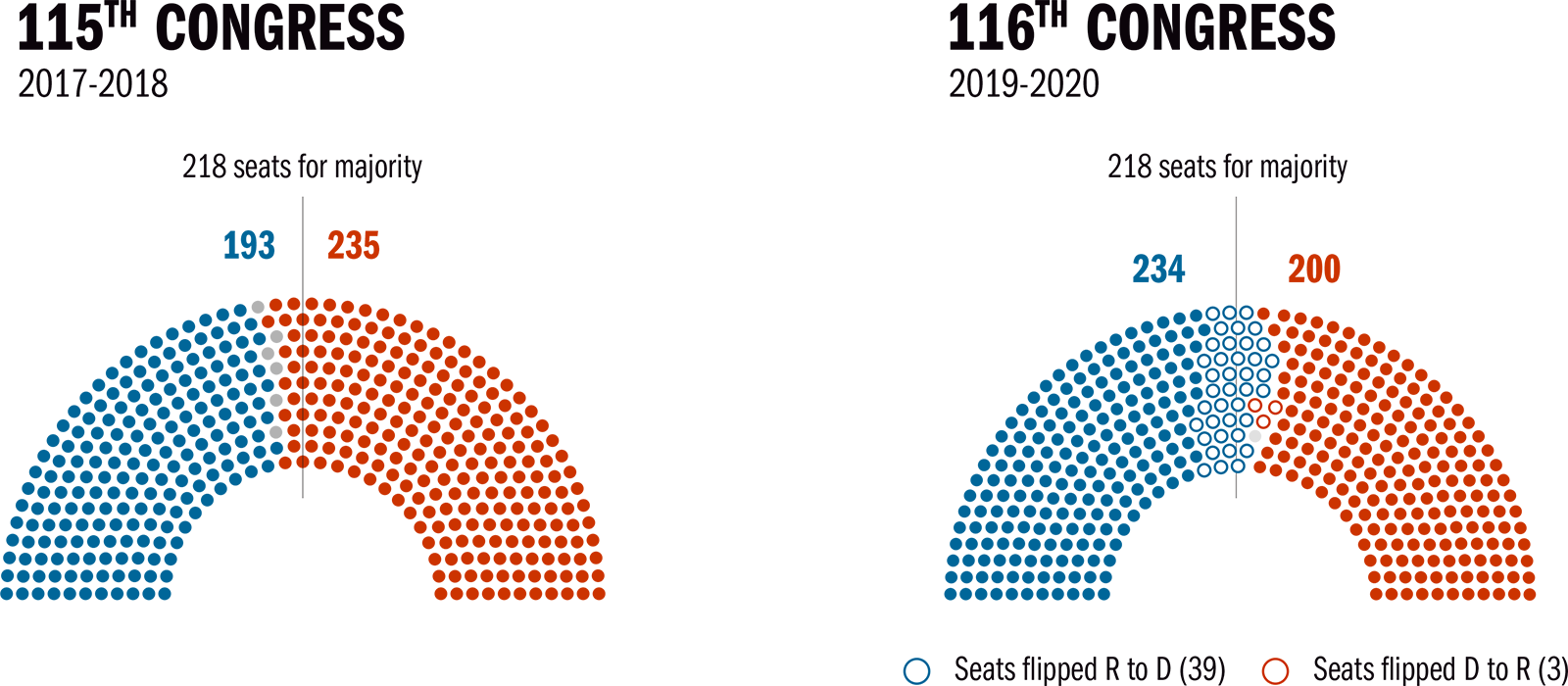
Prior to 2018, the president’s party lost seats in the U.S. House in nine of the last 11 midterm elections. This year’s midterms followed the trend, with Democrats gaining at least 39 seats with two races too close to call as of 11/20/18.
U.S. House Midterm Results by District
Historic trends hold as president’s party suffers midterm losses in the U.S. House.
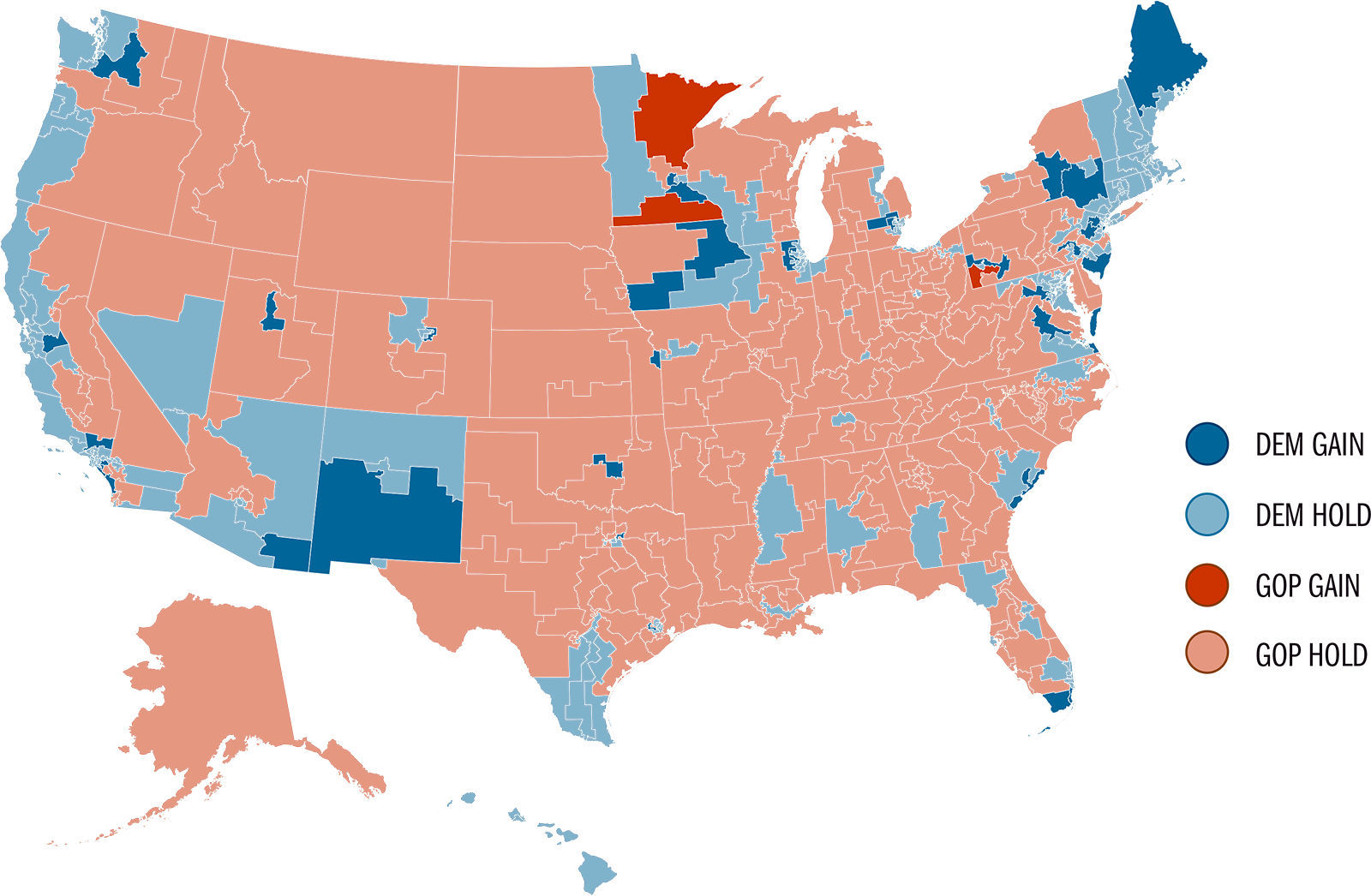
U.S. House Midterm Results by Total Seats
Historic trends hold as president’s party suffers midterm losses in house.
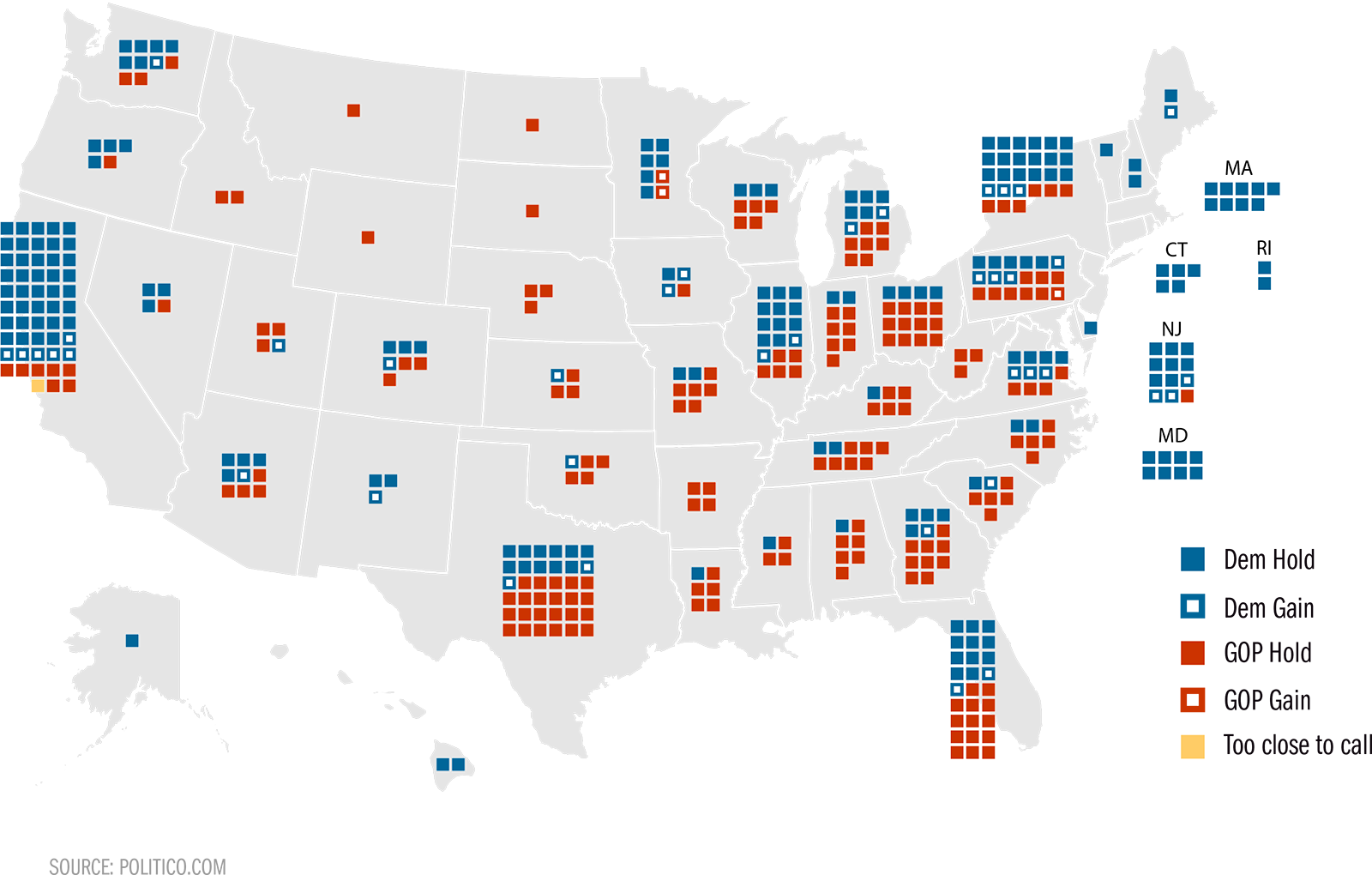
Incumbents Leaving the 115th Congress
Republicans Retirees in the House
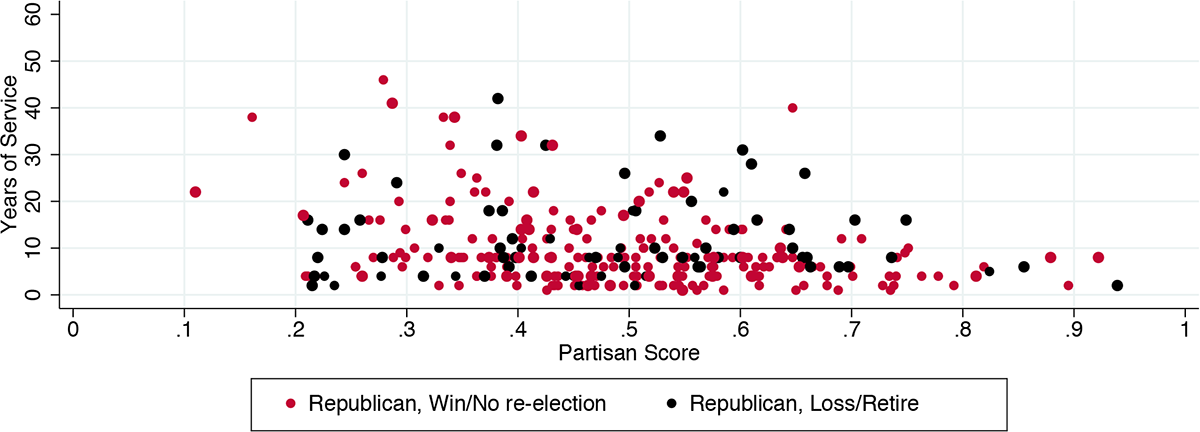
| Name | Years of Service |
|---|---|
| Name | Years of Service |
| Bill Schuster [Pa.-9] | 18 years |
| Blake Farenthold [Texas -27] | 8 years |
| Bob Goodlatte [Va.-6] | 26 years |
| Brian Fitzpatrick [Pa.-8] | 2 years |
| Charles Dent [Pa.-15] | 14 years |
| Darrell Issa [Calif.-49] | 18 years |
| David Reichert [Wash.-8] | 14 years |
| David Trott [Mich.-11] | 4 years |
| Dennis Ross [Fla.-15] | 8 years |
| Diane Black [Tenn.-6] | 8 years |
| Edward Royce [Calif.-39] | 26 years |
| Evan Jenkins [W.V.-3] | 4 years |
| Frank LoBiondo [N.J.-2] | 24 years |
| Gregg Harper [Miss.-3] | 10 years |
| Ileana Ros-Lehtinen [Fla.-27] | 30 years |
| James Renacci [Ohio -16] | 8 years |
| Jason Chaffetz [Utah -3] | 8 years |
| Jeb Hensarling [Texas -5] | 16 years |
| Jim Bridenstine, NASA Administrator [Okla.-1] | 5 years |
| Joe Barton [Texas -6] | 34 years |
| John Duncan, Jr. [Tenn.-2] | 30 years |
| Keith Rothfus [Pa.-12] | 6 years |
| Kevin Cramer [N.D.-1] | 6 years |
| Kristi Noem [S.D.-1] | 8 years |
| Lamar Smith [Texas -21] | 32 years |
| Lou Barletta [Pa.-11] | 8 years |
| Luke Messer [Ind.-6] | 6 years |
| Lynn Jenkins [Kan.-2] | 10 years |
| Mark Sanford [S.C.-1] | 6 years |
| Marsha Blackburn [Tenn.-7] | 16 years |
| Martha McSally [Ariz.-2] | 4 years |
| Mick Mulvaney, Director of U.S. Office of Management and Budget | 6 years |
| Mike Pompeo, Director of CIA [Kan.-4] | 6 years |
| Patrick Meehan [Pa.-7] | 8 years |
| Patrick Tiberi [Ohio -12] | 18 years |
| Paul Ryan [Wisc.-1] | 20 years |
| Raúl R. Labrador [Idaho -1] | 8 years |
| Robert Pittenger [N.C.-9] | 6 years |
| Rodney Frelinghuysen [N.J.-11] | 24 years |
| Ron DeSantis [Fla.-6] | 6 years |
| Ryan Costello [Pa.-6] | 4 years |
| Ryan Zinke, Secretary of Interior [Mont.-1] | 4 years |
| Sam Johnson [Texas -3] | 28 years |
| Steve Pearce [N.M.-2] | 8 years |
| Ted Poe [Texas-2] | 14 years |
| Thomas Garrett [Va.-5] | 2 years |
| Thomas Rooney [Fla.-17] | 10 years |
| Tim Murphy [Pa.-18] | 14 years |
| Todd Rokita [Ind.-4] | 8 years |
| Tom Price, Former Secretary of Health and Human Services | 12 years |
| Trent Franks [Ariz.-8] | 14 years |
| Trey Gowdy [S.C.-4] | 8 years |
Republicans Who Lost Re-election
| Name | Years of Service |
|---|---|
| Name | Years of Service |
| John Culberson [Texas-7] | 18 years |
| Pete Sessions [Texas-32] | 16 years |
| Pete Roskam [Ill.-6] | 12 years |
| Mike Coffman [Colo.-6] | 10 years |
| Leonard Lance [N.J.-7] | 10 years |
| Erik Paulsen [Minn.-3] | 10 years |
| Randy Hultgren [Ill.-14] | 8 years |
| Kevin Yoder [Kan.-3] | 8 years |
| Keith Rothfus [Pa.-12] | 6 years |
| Dana Rohrabacher [Calif.-48] | 6 years |
| Jeff Denham [Calif.-10] | 6 years |
| Dave Brat [Va.-7] | 5 years |
| Bruce Poliquin [Maine-2] | 4 years |
| Mimi Walters [Calif.-45] | 4 years |
| Rod Blum [Iowa-1] | 4 years |
| Barbara Comstock [Va.-10] | 4 years |
| Carlos Curbelo [Fla.-26] | 4 years |
| Dan Donovan [N.Y.-11] | 4 years |
| Steve Russell [Okla.-5} | 4 years |
| David Young [Iowa-3] | 4 years |
| Mike Bishop [Mich.-8] | 4 years |
| Steve Knight [Calif.-25] | 4 years |
| John Faso [N.Y.-19] | 2 years |
| Jason Lewis [Minn.-2] | 2 years |
| Scott Taylor [Va.-2] | 2 years |
| Claudia Tenney [N.Y.-22] | 2 years |
Democratic Retirees in the House
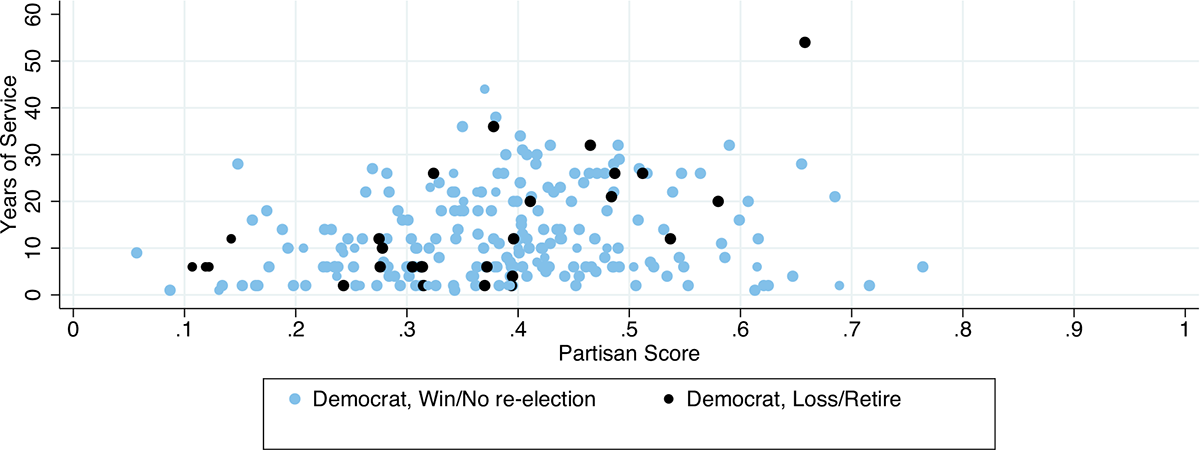
| Name | Years of Service |
|---|---|
| Name | Years of Service |
| Beto O'Rourke [Texas -16] | 6 years |
| Brendan Boyle [Pa.-13] | 10 years |
| Carol Shea-Porter [N.H.-1] | 12 years |
| Colleen Hanabusa [Hawaii -1] | 12 years |
| Elizabeth Etsy [Conn.-5] | 12 years |
| Gene Green [Texas -29] | 2 years |
| Jacky Rosen [Nev.-3] | 2 years |
| Jared Polis [Colo.-2] | 2 years |
| John Conyers Jr. [Mich.-13] | 20 years |
| John Delaney [Md.-6] | 21 years |
| Joseph Crowley [N.Y.-14] | 24 years |
| Keith Ellison [Minn.-5] | 11 years |
| Kyrsten Sinema [Ariz.-9] | 5 years |
| Luis Gutierrez [Ill.-4] | 3 years |
| Michael Capuano [Mass.-7] | 4 years |
| Michelle Lujan Grisham [N.M.-1] | 4 years |
| Niki Tsongas [Mass.-3] | 5 years |
| Rick Nolan [Minn.-8] | 6 years |
| Robert Brady [Pa.-1] | 6 years |
| Ruben Kihuen [Nev.-4] | 6 years |
| Sander Levin [Mich.-9] | 6 years |
| Timothy Walz [Minn.-1] | 6 years |

Gubernatorial Elections |
Democrats Flip Seven Governors’ Seats
Heading into the midterms, Republicans held 33 governorships across the country. Democrats flipped seven previously GOP-held seats and Republicans gained a previously Independent seat in Alaska, resulting in a 27-23 edge heading into 2019.
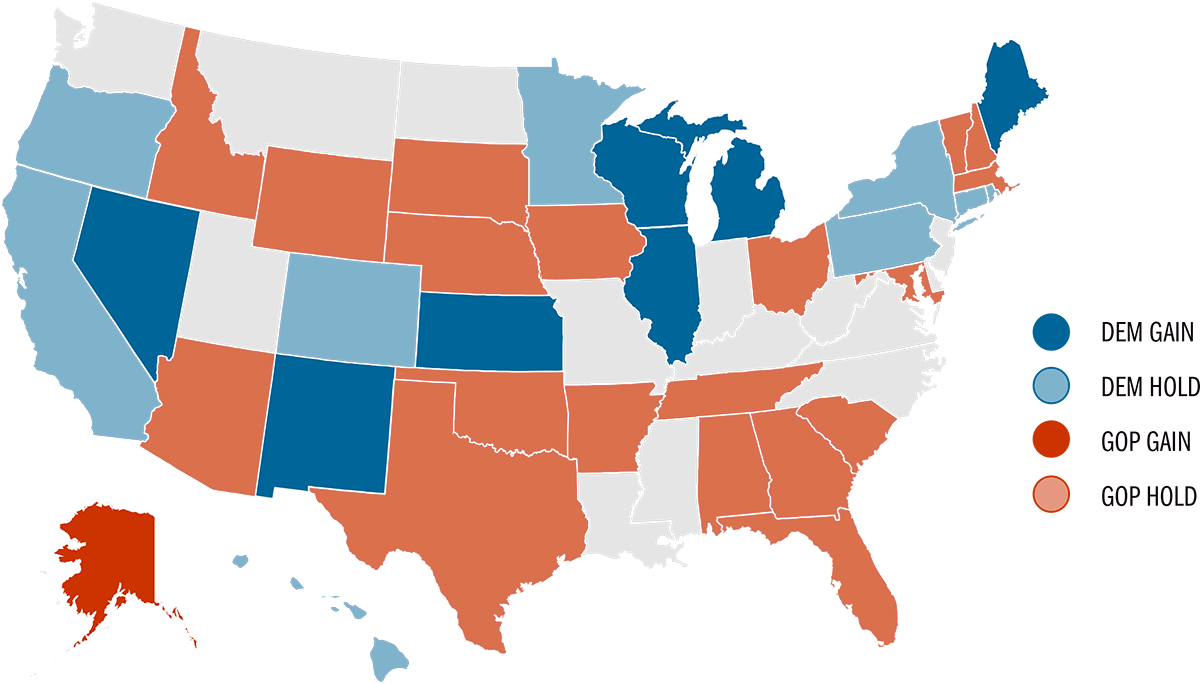
2018 Gubernatorial Election Results
Thirty-six seats were up for election
| Key | |
| Democratic Gain | Democratic Hold |
| Republican Gain | Republican Hold |
*Second-leading vote-getter
|
State Legislatures |
Democrats Make Gains in State Legislatures
By flipping six legislative chambers in five states in the midterm elections, Democrats chipped away at significant Republican control built over the last several years.
*Note: in New Hampshire, both chambers flipped from Republican to Democratic control. After the midterm elections, Minnesota is the only state legislature split between two parties.
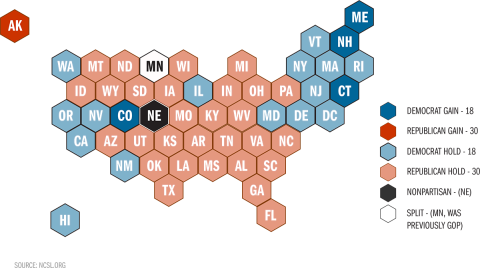
‘Trifecta’ State Control
After the midterm elections 34 states are under ‘trifecta’ control in which one party holds the governorship and both chambers of the legislature. Prior to the election, Republicans had ‘trifecta’ control of 26 states, but Democrats lowered that number to 22 heading into 2019.
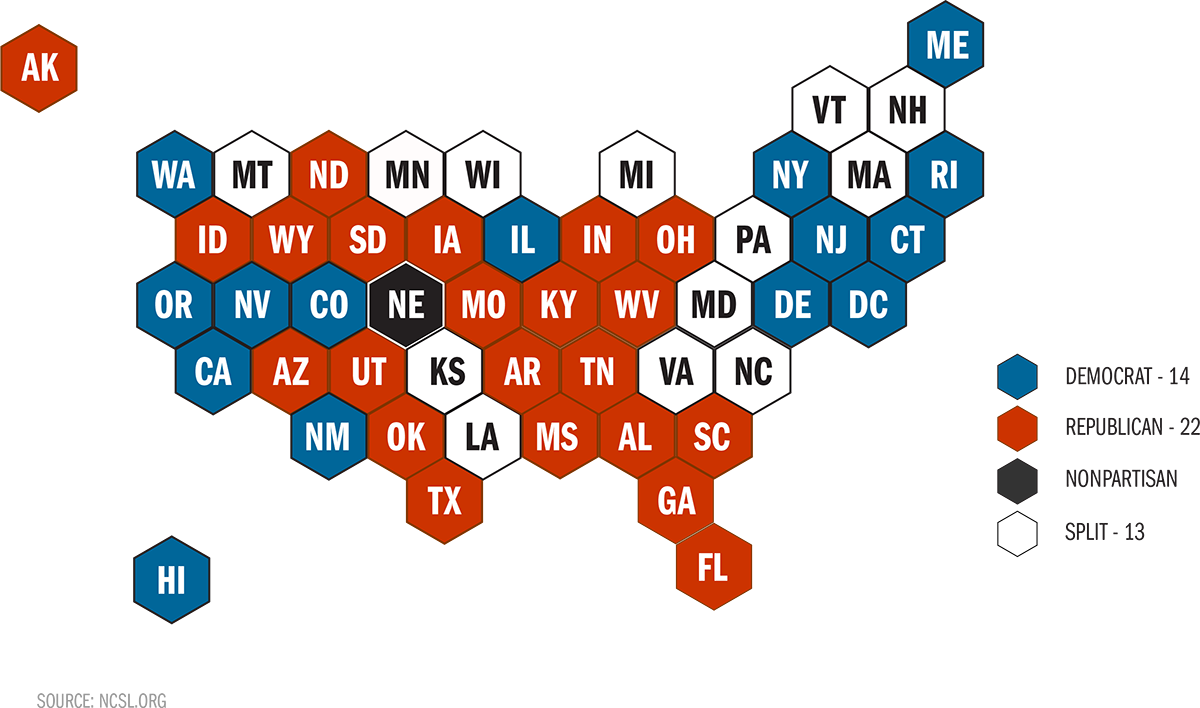
The Federal Legislative Priorities of America’s Counties
| State | Ballot Initiative |
|---|---|
| Arizona |
Energy production: would require 50 percent of energy produced to come from renewable resources by 2030 |
| Arkansas |
Elections policy: would require a voter to present photo identification to vote Minimum wage increase: would increase minimum wage incrementally to $11 by 2022 |
| California |
Fuel tax repeal: would repeal an increase to the fuel tax and vehicle fee set to begin in 2019 Rental housing: would allow local governments to regulate rent on any type of housing |
| Colorado |
Redistricting measures: establishes an independent commission for both congressional and state legislative redistricting |
| Florida |
Right to vote: would restore the right to vote for most individuals with prior felony convictions upon completion of their sentence |
| Hawaii |
Constitutional convention: would allow voters to determine whether or not to hold a constitutional convention to rewrite the Hawaii constitution |
| Idaho |
Medicaid expansion: would expand Medicaid eligibility to those under 65 years old, whose income fall at or below 138 percent of the federal poverty level |
| Michigan |
Legalize marijuana: would legalize, regulate and tax marijuana for recreational usage Redistricting measures: would create a 13 member commission of registered voters taked with redrawing congressional districts every 10 years |
| Missouri |
Medical marijuana: would legalize growing, manufacturing, selling and consuming of marijuana for medicinal use Minimum wage increase: would increase incrementally the state minimum wage to $12 by 2023 |
| Nebraska |
Medicaid expansion: would expand Medicaid eligibility to those under 65 years old, whose income fall at or below 138 percent of the federal poverty level |
| North Carolina |
Elections policy: would require a voter to present photo identification to vote |
| North Dakota |
Legalize marijuana: would legalize, regulate and tax marijuana for recreational usage Right to vote: would clairfy that only U.S. citizens and North Dakota residents can vote in federal, state and local elections |
| Oregon |
Sanctuary state repeal: would repeal Oregon's sanctuary state law which limits cooperation of local law enforcement with federal immigration enforcement |
| South Dakota |
Increase tobacco taxes: would increase that tobacco tax to $2.53 per pack of 20 cigarettes |
| Utah |
Medical marijuana: would legalize growing, manufacturing, selling and consuming of marijuana for medicinal use Medicaid expansion: would expand Medicaid eligibility to those under 65 years old, whose income fall at or below 138 percent of the federal poverty level |
| Washington |
Gun control measures: would raise the minimum age to purchase a gun to 21 and increase waiting period on purchasing of semiautomatic rifles |

County Connections |
County Officials in the U.S. Senate
| Name | State | County, State | County Connection |
|---|---|---|---|
| Dianne Feinstein (D) | CA | San Francisco, Calif. | Supervisor |
| Kamala Harris (D) | CA | Alameda, Calif. | Deputy District County Attorney |
| Christopher A. Coons (D) | DE | New Castle, Del. | Council President/County Executive |
| Joni Ernst (R) | IA | Montgomery, Iowa | Auditor |
| James E. Risch (R) | ID | Ada, Idaho | County Prosecuting Attorney |
| Todd Young (R) | IN | Orange, Ind. | Deputy County Prosecutor |
| Mitch McConnell (R) | KY | Jefferson, Ky. | County Judge-Executive |
| Debbie Stabenow (D) | MI | Ingham, Mich. | Commissioner Chair |
| Amy Klobuchar (D) | MN | Hennepin, Minn. | County Attorney |
| Roy Blunt (D) | MO | Greene, Mo. | Clerk |
| Roger F. Wicker (R) | MS | Lee, Miss. | County Public Defender |
| Catherine Cortez Masto (D) | NV | Clark, Nev. | Commissioner |
| Lindsey Graham (R) | SC | Oconee, S.C. | County Assistant Attorney |
| Tim Scott (R) | SC | Charleston, S. C. | Council Chairman |
| Patrick J. Leahy (D) | VT | Chittenden, Vt. | County Attorney |
| Tammy Baldwin (D) | WI | Dane, Wisc. | Supervisor |
County Officials in the U.S. House of Representatives
| Name | District | County | County Connection |
|---|---|---|---|
| Mo Brooks (R) | [Ala.-5] | Madison | District Attorney |
| David Schweikert (R) | [Ariz.6] | Maricopa | Treasurer |
| Mark DeSaulnier (D) | [Calif.-11] | Contra Costa | Supervisor |
| Jackie Speier (D) | [Calif.-14] | San Mateo | Supervisor |
| Eric Swalwell (D) | [Calif.-15] | Alameda | Deputy District Attorney |
| Anna G. Eshoo (D) | [Calif.-18] | San Mateo | Supervisor |
| Zoe Lofgren (D) | [Calif.-19] | Santa Clara | Supervisor |
| Jimmy Panetta (D) | [Calif.-20] | Alameda | County Prosecutor |
| Salud Carbajal (D) | [Calif.-24] | Santa Barbara | Supervisor |
| Lou Correa (D) | [Calif.-46] | Orange | Supervisor |
| Ken Buck (R) | [Colo.-4] | Weld | District Attorney |
| John Rutherford (R) | [Fla.-4] | Jacksonville-Duval | Sheriff |
| Kathy Castor (D) | [Fla.-14] | Hillsborough | Commissioner |
| Alcee L. Hastings (D) | [Fla.-20] | Broward | County Circuit Court Judge |
| Henry C. “Hank” Johnson Jr. (D) | [Ga.-4] | DeKalb | Commissioner |
| Tulsi Gabbard (D) | [Hawaii-2] | Honolulu | Council Member |
| Jesus "Chewy" Garcia (D) | [Ill.-4] | Cook | Commissioner |
| Mike Quigley (D) | [Ill.-5] | Cook | Commissioner |
| Danny K. Davis (D) | [Ill.-7] | Cook | Commissioner |
| Mike Bost (R) | [Ill.-12] | Jackson | Commissioner |
| John Shimkus (R) | [Ill.-15] | Madison | Treasuerer |
| Adam Kinzinger (R) | [Ill.-16] | McLean | County Board Member |
| Jim Banks (R) | [Ind.-3] | Whitley | Councilmember |
| Jim Baird (R) | [Ind.-4] | Putnam | Commissioner |
| André Carson (D) | [Ind.-7] | Indianapolis-Marion | City- County Council |
| Thomas Massie (R) | [Ky.-4] | Lewis | Judge Executive |
| Harold Rogers (R) | [Ky.-5] | Pulaski-Rockcastle | Commonwealth Attorney |
| William R. Keating (D) | [Mass.-9] | Norfolk | County District Attorney |
| C. A. Dutch Ruppersberger (D) | [Md.-2] | Baltimore | County Executive |
| Daniel Kildee (D) | [Mich.-5] | Genessee | Commissioner |
| Pete Stauber (R) | [Minn.-8] | St. Louis County | Commissioner |
| Michael Guest (R) | [Miss.-3] | Madison County | County Prosecutor |
| Donald M. Payne Jr. (D) | [N.J.-10] | Essex | Freeholder |
| Peter T. King (R) | [N.Y.-2] | Nassau | Comptroller |
| Thomas Suozzi (D) | [N.Y.-3] | Nassau | County Executive |
| Gregory W. Meeks (D) | [N.Y.-5] | Queens | Assistant County District Attorney |
| Paul Tonko (D) | [N.Y.-20] | Montgomery | Supervisor Chairman |
| Joe Morelle (D) | [N.Y.-25] | Monroe | County Legislator |
| Brian Higgins (D) | [N.Y.-26] | Erie | Buffalo Common Council |
| Chris Collins (R) | [N.Y.-27] | Erie | County Executive |
| Steve Chabot (D) | [Ohio-1] | Hamilton | Commissioner |
| Joyce Beatty (D) | [Ohio-3] | Montgomery | Director of Health and Human Services |
| Robert E. Latta (R) | [Ohio-5] | Wood | Commissioner |
| David P. Joyce (R) | [Ohio-14] | Geauga | County Prosecutor |
| Earl Blumenauer (D) | [Ore.-3] | Multnomah | Commissioner |
| Peter A. DeFazio (D) | [Ore.-4] | Lane | Commissioner |
| Kurt Schrader (D) | [Ore.-5] | Clackamas | Planning Commissioner |
| Tom Marino (R) | [Pa. -10] | Lycoming | County District Attorney |
| Tom Rice (R) | [S.C. -7] | Horry | Council Chairman |
| Tim Burchett (R) | [Tenn. -2] | Knox | Mayor |
| Steve Cohen (D) | [Tenn. -9] | Shelby | Commissioner |
| Louie Gohmert (R) | [Texas -1] | Smith | County District Court Judge |
| Ron Wright (R) | [Texas -6] | Tarrant | Tax Assessor |
| Al Green (D) | [Texas -9] | Harris | Justice of the Peace |
| Veronica Escobar (D) | [Texas -16] | El Paso | Judge Executive |
| John R. Carter (R) | [Texas -31] | Williamson | District Court Judge |
| Ben McAdams | [Utah -4] | Salt Lake | County Mayor |
| Robert J. Wittman (R) | [Va. -1] | Westmoreland | Supervisor |
| Gerald E. Connolly (D) | [Va. -11] | Fairfax | Supervisor |
| Rick Larsen (D) | [Wash. -2] | Snohomish | Council Member |
| Mark Pocan (D) | [Wisc. -2] | Dane | Supervisor |
| Ron Kind (D) | [Wisc. -3] | La Crosse | Assistant State Prosecutor |
| Sean P. Duffy (R) | [Wisc. -7] | Ashland | County District Attorney |
|
Looking Ahead: County Priorities in the ‘Lame Duck’ and 116th Congress |
Looking Ahead: Timeline
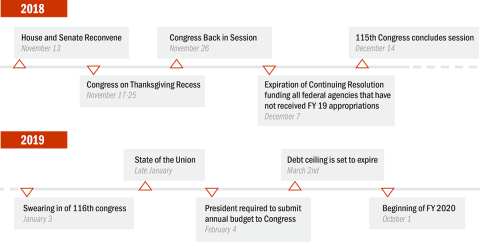
The Federal Legislative Priorities of America’s Counties
Listed below are NACo’s 2017-2018 Federal Legislative Priorities. This slide will be be updated on December 7, when NACo’s Board of Directors will approve the organization’s 2018-2019 Legislative Priorities at its Fall Board Meeting.
Promote County Infrastructure Priorities
NACo will work with the Administration and Congress to ensure that any infrastructure package, including reauthorization of the Water Resources Development Act and the Highway Trust Fund, reflects the following county priorities: allocating more funding for locally owned infrastructure, increasing local decision-making authority and prioritizing investments that increase economic development, mobility and safety.
Support the Payment in Lieu of Taxes (PILT) and Secure Rural Schools (SRS) Programs
NACo supports restoring full mandatory funding for the Payments in Lieu of Taxes (PILT) program, which compensates counties for untaxable federal land within their boundaries. NACo also supports extending the Secure Rural Schools (SRS) program as a transitional funding mechanism until the federal government fully implements a sustainable long-term forest management program with adequate revenue sharing for forest counties and schools.
Support Policies to Promote Mental Health, Substance Abuse Treatment and Justice Reform
NACo supports measures that enhance the ability of counties to prevent and treat mental illness and substance use disorders, both in the community and within the context of the criminal justice system. NACo also supports programs and legislation that divert non-violent individuals struggling with mental illness and/or substance use disorders from jails and into treatment programs while protecting overall public safety.
Protect the Federal-State-Local Partnership for Medicaid
NACo supports protecting the federal-state-local partnership structure for financing and delivering Medicaid services while maximizing flexibility to support local systems of care. Counties are concerned about measures that would further shift Medicaid costs to counties, including proposals to institute block grants or per capita caps. These proposals would increase the amount of uncompensated care provided by counties and reduce counties’ ability to provide for the health of our residents. NACo also supports targeted efforts to enhance flexibility in the program to support local systems of care, including easing Medicaid’s Institute of Mental Diseases (IMD) and inmate exclusions.
Work Towards a More Effective Definition of Waters of The U.S.
NACo believes that local streets, gutters and human-made ditches should be excluded from the definition of “Waters of the U.S.” (WOTUS) under the federal Clean Water Act. NACo calls on Congress to require the U.S. Environmental Protection Agency and U.S. Army Corps of Engineers to withdraw the new WOTUS rule and to rewrite it in consultation and collaboration with state and local governments.
Support County Authority to Collect Existing Sales Tax
NACo supports legislation to permit the collection of existing sales and use taxes from remote sellers. The issue of collecting remote sales taxes has taken on greater significance in recent years due to the Internet’s growth as a retail marketplace. As a result, state and local governments have lost billions in uncollected sales taxes and Main Street businesses find themselves at a significant competitive disadvantage to online merchants. This disadvantage is amplified because online merchants and their customers use and benefit from local infrastructure and services without contributing to their provision.
Support Programs That Assist Counties to Prevent and Reduce Poverty
NACo supports federal investments and strategies that focus on serving those most in need and the root causes of poverty. Because counties are responsible to maintain the local social safety net and are typically mandated to provide indigent care, NACo supports fully funding programs that assist our nation’s most vulnerable populations and maintain the maximum amount of flexibility possible at the local level. Key federal programs that assist counties in tackling poverty include the Social Services Block Grant and the Temporary Assistance for Needy Families program.
Support a Comprehensive Long-Term Farm Bill Reauthorization
NACo supports a long-term reauthorization of the farm bill to help counties provide critical investments in our nation’s most underserved communities. In addition to a long-term reauthorization, NACo also supports full funding for all farm bill titles, which help strengthen our nation’s rural infrastructure including broadband and water and wastewater systems, protect our nation’s food supply, increase access to healthy food to low-income populations through the Supplemental Nutritional Assistance Program (SNAP), and promote environmental stewardship and conservation.
After the Election: The Lame Duck Session of the 115th Congress
Following the November 6 elections, the 115th Congress will reconvene for about a month to complete a few outstanding items. While some issues, such as government funding for the remainder of FY 2019, must be completed, action on other items may be postponed until the 116th Congress.
- Appropriations: Before the elections, Congress passed and the president signed five of the 12 annual spending bills into law accompanied by a continuing resolution (CR) extending government funding for all other agencies through December 7. Legislators now must reach agreement on final spending bills or a new CR by that date to avoid a partial government shutdown. President Trump has suggested he could seek a shutdown if the final spending agreement does not include certain provisions, including funding for a wall along the southern border. FY 2019 began on October 1, 2018 and runs through September 30, 2019.
- National Flood Insurance Program (NFIP): In July, Congress passed a short term NFIP extension that expires on November 30, 2018. Lawmakers have worked over the past year to enact a long-term authorization for the program but have yet to reach a final agreement. NFIP’s last long-term authorization was passed in 2012 under the Biggert-Waters Flood Insurance Reform Act of 2012, which expired Sept. 30, 2017.
- Farm Bill: Both the House and Senate passed their versions of the farm bill reauthorization in June but could not reach an agreement on a compromise version before the expiration of the 2014 Farm Bill on October 1, 2018. Key differences remain in nutrition program funding and crop insurance subsidies, which must be resolved before sending a final bill to the president. If leadership is unable to reach an agreement on these issues, reauthorization of the farm bill could be pushed to the 116th Congress.
- Criminal Justice Reform: With a renewed push by Congress and the administration, criminal justice reform could see action during the lame duck session. The cornerstone piece of legislation, the First Step Act, was passed by the House in May and is considered a top priority in the Senate following the return of lawmakers in November. A more comprehensive package could be addressed in the 116th Congress.
- Health Policy Changes and Tax Delays: As Congress works to finalize FY 2019 appropriations in the lame duck session, some health-related provisions could be included in or attached to the spending bills. These provisions include changes to pharmaceutical regulations and further delays of certain health taxes, including a county-supported delay of the so-called “Cadillac Tax” on high-cost employer health insurance plans.
Looking ahead: County Priorities and the 116th Congress
The 2018 midterm elections resulted in a divided 116th Congress in which both parties could struggle to advance legislative priorities, but on some issues – including several key county issues – alignment of the parties’ priorities could result in bipartisan agreement on major pieces of legislation.
Infrastructure Package
The Issue: Infrastructure development has been a priority of both parties and the administration over the last two years, with the President proposing a significant infrastructure package in March 2018. House Democrats are expected to reintroduce their $1 trillion infrastructure package that was outlined earlier this year once they take control in January 2019. Provisions could include stabilizing the Highway Trust Fund (HTF) and providing federal funds to address the national backlog of infrastructure repair.
County Impact: Counties own 45 percent of the nation’s roads and 40 percent of the nation’s bridges, along with a third of airports across the country. Counties are central to the development and maintenance of the national infrastructure network, including surface transportation, rail, ports, hospitals, schools and other economic development.
The Outlook: Infrastructure is regarded by many as the most likely field for bipartisan action in the 116th Congress. House Democrats will hope to advance a package reflecting their priority in the first half of 2019, and the administration is also expected to review and refresh the proposal they put forward next year.
Farm Bill Reauthorization
The Issue: In June 2018, both the U.S. House of Representatives and U.S. Senate developed and passed their respective farm bill reauthorizations. Since then, lawmakers have been at odds on whether to overhaul work requirements for the Supplemental Nutrition Assistance Program (SNAP, formerly known as food stamps) and other provisions as they work to reconcile differences between the House- and Senate-approved bills.
County Impact: The farm bill helps counties make critical investments in infrastructure, workforce and economic development, and nutrition and conservation for some of our nation’s most underserved communities. Preserving these programs is key to the strength and stability of our local and national economy.
The Outlook: Now that the election is over, farm bill conference committee members are expected to meet again in early November. With the Democrats gaining control of the House beginning in January, there are two paths forward for farm bill reauthorization – first, leadership may resolve differences between the two bills, or, second, the Democrat-controlled House will introduce a new farm bill and begin the process anew next year.
Waters of the U.S. (WOTUS)
The Issue: In 2015, the Obama Administration finalized a controversial new “Waters of the U.S.” definition under the Clean Water Act that was immediately challenged in the courts. Currently, the 2015 WOTUS definition is rule-of-law in 22 states; in the other 28 states, there is a one-year delay on implementation to allow the cases to move through the courts. In the meantime, the Trump Administration has been working to withdraw and rewrite the rule, and a proposed rule to replace the 2015 WOTUS definition is expected by the end of the year.
County Impact: Counties have expressed concerns with the Obama-era rule due to its broader interpretation of WOTUS and the potential impact it could have on county-owned and maintained roads and roadside ditches, bridges, flood control channels, drainage conveyances and wastewater and stormwater systems. Counties have called for the 2015 WOTUS rule to be withdrawn and rewritten in consultation and collaboration with state and local governments.
The Outlook: In the U.S. House, Democrats are likely to introduce WOTUS-related bills to keep the 2015 rule in place, while the administration and the U.S. Senate will continue working to rewrite the 2015 version of the rule. Legislators may also try to attach policy riders to certain House appropriations bills to prevent the Environmental Protection Agency from moving forward with a new WOTUS rule.
Addressing the Opioid Crisis
The Issue: In October 2018, President Trump signed a massive bill into law directed at addressing the opioid epidemic. Many of the programs authorized under the legislation will need funds appropriated, and new legislation and programs may also be considered, especially related to how Medicaid and Medicare can help stem the epidemic.
County Impact: Counties are on the front lines of addressing the epidemic through prevention, treatment, crisis response and recovery. Many new federal programs could provide funding or training opportunities for county first responders, community health centers and other county agencies impacted by substance use issues.
The Outlook: Continued funding for Medicaid and Medicare programs that address the opioid crisis is likely, particularly through provisions outlined in the Substance Use-Disorder Prevention that Promotes Opioid Recovery and Treatment (SUPPORT) for Patients and Communities Act (H.R. 6) passed earlier this year. A continued focus on this issue is likely to include the expansion of treatment resources for health care providers and enhanced recovery supports for patients.
Temporary Assistance for Needy Families (TANF) Reauthorization
The Issue: The TANF program has operated on a series of short-term extensions since the last major reauthorization expired in 2010. The program provides funds to states to operate cash assistance, child care and other programs for individuals and families.
County Impact: Counties administer TANF in ten states making up over half of the total population covered by the TANF program. Changes in program funding or structure could impose increased administrative requirements on county agencies. Counties support better streamlining federal assistance programs to allow county agencies to work in tandem to produce results for individuals and communities.
The Outlook: In May 2018, the U.S. House Ways and Means Committee advanced a TANF reauthorization that would extend the program through FY 2023 and enact changes to its structure. On the other side of the capitol, the U.S. Senate is in the beginning stages of developing its own version of a TANF reauthorization bill. With Democrats taking control of the House and Republicans maintaining control in the Senate, bipartisan consensus on the next TANF reauthorization bill will be necessary.
Federal Appropriations Cycle for FY 2020
The Issue: Once Congress completes the FY 2019 appropriations cycle, lawmakers will immediately turn their attention to FY 2020 spending levels, which must be completed by September 30, 2019. The president will also release an annual budget request, likely in February 2019.
County Impact: Counties receive significant funds from the federal government through a wide variety of programs, including criminal justice, economic development, health, the Payments In-Lieu of Taxes (PILT) program and many others. Ensuring continuity of funding allows counties to better plan annual budgets.
The Outlook: In previous fiscal years, the Trump Administration’s budget requests eliminated federal funding for some key community and economic development programs for state and local governments, though Congress has continued to provide funding for the programs like the U.S. Department of Housing and Urban Development’s Community Development Block Grant (CDBG) and HOME Investment Partnerships (HOME), and the U.S. Department of Commerce’s Economic Development Administration (EDA). Other programs, such as PILT, received full funding in FY 2019 and is on track to receive substantial funding in FY 2020.
Addressing Adverse Weather Conditions and Natural Disasters
The Issue: In 2017, 25 percent of all counties – 813 of the nation’s 3,069 counties – received at least one major presidential disaster declaration. These events caused more than $300 billion in damages, including 16 disaster events with losses exceeding $1 billion each. This year, this staggering trend is continuing with another round of devastating wildfires, floods and storms.
County Impact: Regardless of whether manmade or due a natural warming cycle, counties will need to adapt and mitigate for stronger hurricanes, extreme flooding, longer droughts, more severe wildfires and other natural disasters. These events result in significant losses of life and property for communities and place substantial stress on our environment, public health, public safety, infrastructure and overall community vitality.
The Outlook: While a record $140 billion in federal disaster aid was appropriated last year, additional mitigation and recovery needs are mounting, including for public lands counties. Additionally, House Democrats have indicated plans to reanimate the House Select Committee on Energy Independence and Global Warming, which last operated from 2007-2011. While the select committee did not have the authority to take legislative action on bills, it did convene hearings to study our changing climate and its impacts on the nation.
Immigration Reform
The Issue: Lawmakers have debated comprehensive immigration reform for almost a decade, balancing the need to reform the immigration system with increased border security concerns. While the Trump Administration has taken some actions through executive orders, including limiting travel from certain countries and adjusting the asylum process, wholesale changes to the immigration system require legislative action from Congress.
County Impact: In the debate over immigration reform, the county perspective is often overlooked; yet, from an operational and managerial standpoint, counties are central players. From providing translators in crisis communications centers and public English as a second language teachers, to helping migrants develop businesses and increase the tax base, county operations of all sizes across the country must deal with the impacts of immigration as county leaders seek to integrate foreign-born residents into their communities. Immigration can have a significant impact on county budgets, funding, service provisions and personnel.
The Outlook: Immigration reform could be one of the most divisive issues of the 116th Congress. However, significant bipartisan action has occurred on immigration in previous Congresses, including in 2013 when a bipartisan bill authored by the “Gang of Eight” passed the U.S. Senate. A split Congress could produce an environment conducive to bipartisan efforts on immigration.


